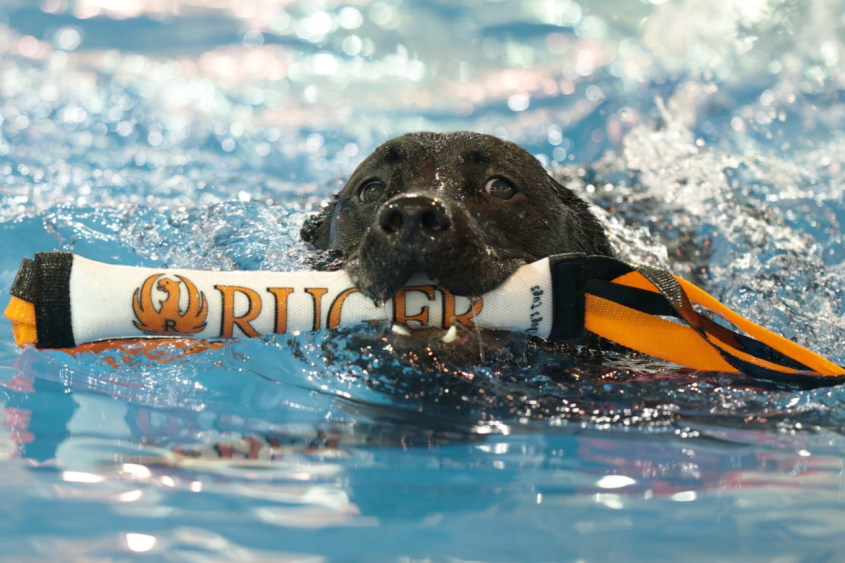Elbow dysplasia patient benefits from early intervention
Ruger loves water. At six months old, the black Labrador Retriever was already jumping in every pond he encountered. Within the next two months, he received his first dock diving lesson and participated in his first competition.
Dock diving is a sport where dogs launch themselves off a 40-feet long dock into a pool to retrieve a toy. Dogs with the farthest jump distance win. At eight months old, Ruger was already scoring jumps in the 20-feet range. The longest jump at the dock diving event at the 2023 Westminster Kennel Club Dog Show was 25.5 feet, and the longest on record is over 30 feet.
Just as he was on his way to dock diving success, Ruger began to limp.
“The lameness started just after his second dock diving competition, when Ruger was 10 months old,” says Rhea Adams, Ruger’s owner and a licensed veterinary technician in orthopedic surgery at the Cornell University Hospital for Animals (CUHA). “I was terrified that this could be the end of it.”
Having seen similar lameness in many CUHA patients, Adams immediately recognized the symptoms of elbow dysplasia. Elbow dysplasia is a common, congenital condition where a small piece of joint margin breaks off and causes damage to elbow joint. “It’s quite painful for the dog. It’s like walking with a rock in your shoe,” says Adams.
The condition is particularly common in young Labradors, affecting 10% of these dogs, according to the Orthopedic Foundation for Animals (OFA). With his wide gait and tucked elbows — other telltale signs of the condition — Adams suspected that Ruger might be affected before he started to limp.
Adams brought Ruger to CUHA for further analysis. A CT scan revealed one fragment the size of a split pea and several smaller pieces in the left elbow. In the right elbow, the fragments were not fully detached. Fragments of this size are typical, although in some cases they can reach the size of a blueberry.
Following his diagnosis, Ruger was scheduled for a minimally invasive procedure called elbow arthroscopy, in which a minuscule camera is inserted into the joint, allowing the surgeon to see and remove the bone fragments and clean the inside of the joint.

After the surgery, Ruger was prescribed three months of physical therapy to recover his muscle strength, joint mobility and range of motion. “I was worried about what sport would look like for him,” says Adams. Twice a week, Ruger diligently practiced his prescribed combination of underwater treadmill and land exercises.
According to Dr. Ursula Krotscheck, professor and section chief in the Section of Small Animal Surgery at CUHA, who performed the surgery, it was essential that Ruger was treated as soon as his lameness appeared. “In all large, young dogs, even if front leg lameness is intermittent, owners should seek veterinary assistance immediately,” says Krotscheck. “How much the dog improves after surgery may depend on how much the arthritis has progressed at the time of the procedure.”
Most dogs will develop elbow dysplasia before the age of one. Unfortunately, dogs with bilateral dysplasia, or dysplasia in both limbs, may have a symmetrical gait, and lameness can be hard to recognize. Lameness can also be difficult to notice in dogs with a mild elbow dysplasia. These dogs are generally diagnosed later when arthritis is more advanced. “If you acquire a purebred dog, you should ask for the OFA score of its parents,” says Krotscheck. The OFA score is a rating system that grades — from excellent to severe — X-rays of a dog’s hips and elbows to help conscientious breeders identify potential issues in their lines.
Arthritis cannot be reversed or cured, and it is expected to progress in all patients with elbow dysplasia. However, it can be managed with a clinical team and a dedicated owner.
Dogs like Ruger with only mild arthritis can still be sore after intense exercise. “It is normal to be sore and have bad days,” says Krotscheck. “In these cases, it’s best to rest or take some inflammatory medications as needed and prescribed by the clinical team.”
Although Ruger doesn’t seem bothered by his condition, he is not cured. “Ruger has arthritis and may eventually develop some lameness as he ages,” says Krotscheck.
But for now, Ruger’s career as an athlete is back on track. He takes glucosamine and chondroitin supplements. His jumps are in the lower range of what he was jumping before, but he is not hampered by his elbow dysplasia. This year, he competed at the dock diving event at the Westminster Kennel Club Dog Show. “That’s an experience I will never forget. That was amazing,” says Adams.
Besides early detection and surgery, Krotscheck attributes the positive outcome in Ruger’s case to three factors: physical therapy, activity and weight management. “Ruger is a great example of how functional a dog can be when the owner follows the veterinary recommendations, doing the full course of physical therapy, keeping their dog active, and slim,” says Krotscheck.
“My message for other people who have a dog with this condition is that elbow dysplasia is not a final verdict,” says Adams. “With the right treatment, these dogs can still be active. They can still be an athlete.”
Written by Elodie Smith





